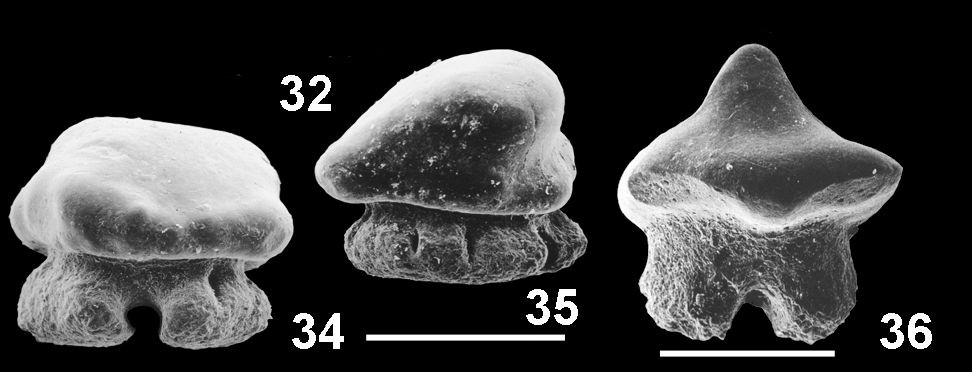Dasyatis northdakotaensis
Hoganson, Erickson & Holland, 2019
Classification: Elasmobranchii Myliobatiformes Dasyatidae
Reference of the original description
Chondrichthyan and Osteichthyan Paleofaunas from the Cretaceous (Late Maastrichtian) Fox Hills Formation of North Dakota, USA: Paleoecology, Paleogeography, and Extinction. Bulletins of American Paleontology, 398, 1–94
Chondrichthyan and Osteichthyan Paleofaunas from the Cretaceous (Late Maastrichtian) Fox Hills Formation of North Dakota, USA: Paleoecology, Paleogeography, and Extinction. Bulletins of American Paleontology, 398, 1–94
Description:
Citation: Dasyatis northdakotaensis Hoganson, Erickson & Holland, 2019: In: Database of fossil elasmobranch teeth www.shark-references.com, World Wide Web electronic publication, Version 01/2026
Please send your images of "Dasyatis northdakotaensis" to info@shark-references.com

Dasyatis northdakotaensis sp. nov., 9.34, 9.35, holotype, probable female (ND 94-38.20); 9.36, allotype, probable male (ND 94-38.11). © Hoganson et al. (2019)

Dasyatis northdakotaensis sp. nov., 9.34, 9.35, holotype, probable female (ND 94-38.20); 9.36, allotype, probable male (ND 94-38.11). © Hoganson et al. (2019)
Description
Original diagnosis after Hoganson et al. (2019) p. 40 [27441]: Teeth extremely small; crown of female tooth is bulbous with a subrectangular outline in occlusal view. Crown surfaces smooth; lingual face of crown is convex, producing a concavity extending around the lingual and labial margins of the crown. Crown overhangs root around the entire margin; labial visor of crown weakly crenulate. Root robust and bilobate; each lobe is subrectangular. Large nutritive groove that contains three basal foramina separates root lobes. Several nutritive foramina penetrate margins of tooth; basal attachment sutures of root lobes are slightly convex. Crown of male tooth is subrectangular in occlusal outline, smooth, and possesses a distinct cusp. Lingual face of crown has indentation on either side of the central cusp. Cutting edge extends from tip of crown to nearly the lateral margins of the crown. Subtriangular root lobes are separated by nutritive groove containing one central foramen; tips of root lobes project beyond lingual face of crown. Root lobes are proportionately smaller than on female tooth.
Original diagnosis after Hoganson et al. (2019) p. 40 [27441]: Teeth extremely small; crown of female tooth is bulbous with a subrectangular outline in occlusal view. Crown surfaces smooth; lingual face of crown is convex, producing a concavity extending around the lingual and labial margins of the crown. Crown overhangs root around the entire margin; labial visor of crown weakly crenulate. Root robust and bilobate; each lobe is subrectangular. Large nutritive groove that contains three basal foramina separates root lobes. Several nutritive foramina penetrate margins of tooth; basal attachment sutures of root lobes are slightly convex. Crown of male tooth is subrectangular in occlusal outline, smooth, and possesses a distinct cusp. Lingual face of crown has indentation on either side of the central cusp. Cutting edge extends from tip of crown to nearly the lateral margins of the crown. Subtriangular root lobes are separated by nutritive groove containing one central foramen; tips of root lobes project beyond lingual face of crown. Root lobes are proportionately smaller than on female tooth.
References

Global impact and selectivity of the Cretaceous-Paleogene mass extinction among sharks, skates, and rays. Science, 379, 802–806
DOI: 10.1126/science.abn2080

Global impact and selectivity of the Cretaceous-Paleogene mass extinction among sharks, skates, and rays. Science, 379, 802–806
DOI: 10.1126/science.abn2080


















